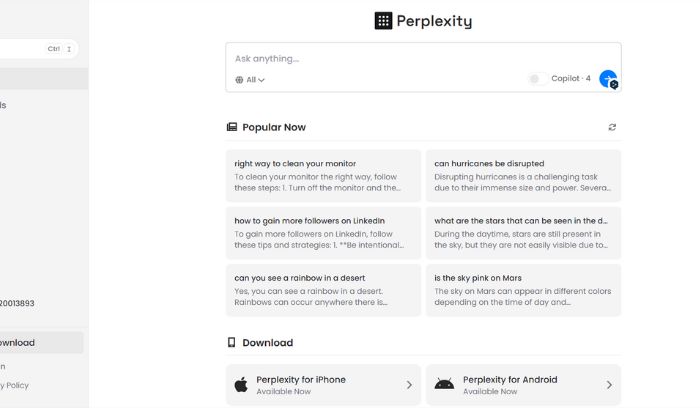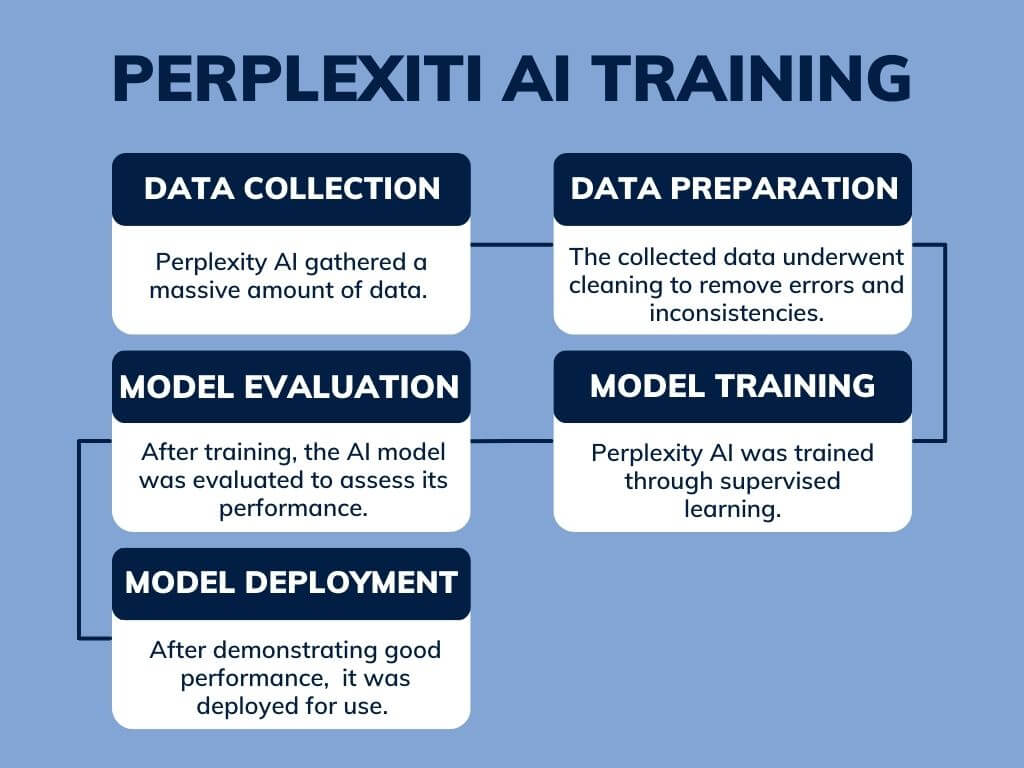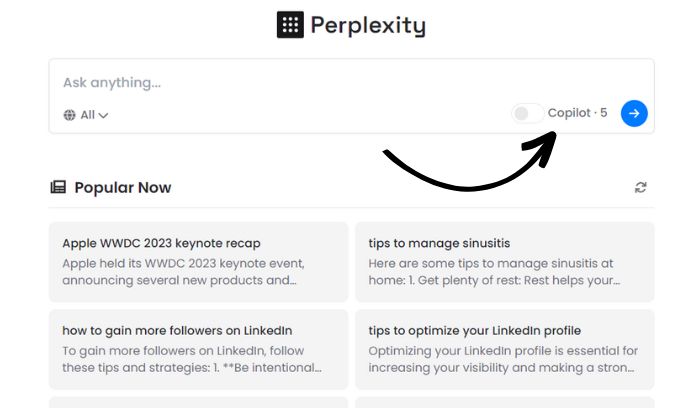In August 2022, four future predictors introduced an advanced long-form question-answering AI called Perplexity Ai that can deliver almost accurate answers to questions.
This latest AI language model is becoming the craze right now.
It’s a revolutionary technology because they reached 2 million monthly active users in just four months. And many investors have already raised their hands to give them enough funds.

Many users are impressed by their incredibly powerful search engine, which can display the source of information it provides. This feature makes Perplexity AI more trustworthy than other question-answering AI tools.
So let’s not waste any time and delve into the details of what Perplexity AI is.
What Is Perplexity AI?
Perplexity AI is a chatbot that uses machine learning and natural language processing (NLP) to respond to user questions. It was founded in 2022 by Andy Konwinski, Aravind Srinivas, Denis Yarats, and Johnny Ho.
Perplexity AI acts as an extremely powerful search engine, and when a user inputs a question, the model scours the internet to give an answer.

This impressive AI search engine works by using a large language model to understand the meaning of a question and then to search the web for the best answers. The language model is trained on a massive dataset of text and code, which allows it to understand a wide range of questions.
Perplexity AI is a promising new search engine that has the potential to revolutionize the way people search for information.
Who Built Perplexity AI?
Perplexity AI is a San Francisco-based company that was founded in August 2022 by four engineers with backgrounds in back-end systems, AI, and machine learning:
- Aravind Srinivas is the CEO and co-founder of Perplexity AI. He previously worked on language and diffusion generative models at OpenAI.
- Denis Yarats is the CTO and co-founder of Perplexity AI. He previously worked as an AI research scientist at Facebook AI Research.
- Johnny Ho is a co-founder of Perplexity AI. He previously worked as an engineer at Quora, then as a quantitative trader on Wall Street.
- Andy Konwinski is a co-founder of Perplexity AI. He is also a co-founder of Databricks.
Now Perplexity AI is run by a small team of 14 AI enthusiasts who are mostly engineers but the good thing is this team is growing rapidly.
Perplexity AI has raised $28.7 million in funding from investors such as Susan Wojcicki (Former CEO of Youtube), Databricks Ventures, Nat Friedman (Former CEO of GitHub), Paul Buchheit (Creator of Gmail), and many more renowned personalities.
You can check their complete team members and investors’ list here.
The founders aim to be the best platform for answers and information, serving as the go-to source for people seeking quick and accurate responses tailored to their queries.
How Was Perplexity AI Trained?
Perplexity AI has been trained on a vast amount of text and code, including Wikipedia, books, articles, and open-source projects. It utilized a process known as supervised learning, wherein it learned to predict the output based on the given input.
The training process took several months, during which Perplexity AI analyzed and understood patterns in language and code. This extensive training allows the AI to handle a wide variety of queries and provide accurate responses.

Here’s a breakdown of how Perplexity AI was trained:
1. Data collection: Perplexity AI gathered a massive amount of text and code from different sources like Wikipedia, books, articles, and open-source projects.
2. Data preparation: Before training, the collected data underwent cleaning to remove errors and inconsistencies. It was also tokenized, breaking it down into individual words or tokens for analysis.
3. Model training: Using the prepared data, Perplexity AI was trained through supervised learning. It was given input and corresponding desired output examples, such as text and the Wikipedia article it relates to. The AI learned to predict the output based on the input it received.
4. Model evaluation: After training, the AI model was evaluated to assess its performance. Test data was fed to the model, and its ability to predict the output was measured.
5. Model deployment: Once the AI model demonstrated good performance during evaluation, it was deployed for use. This meant it could be utilized to answer user queries effectively.
Perplexity AI continues to undergo training and updates to enhance the accuracy and performance of its search engine.
How Does Perplexity AI Work?
Perplexity AI is a smart search engine and chatbot that gives accurate answers to difficult questions. Here’s a simple explanation of how does Perplexity AI works:
Perplexity AI uses a special technology called large language models (LLMs) to understand and respond to questions. These models have been trained using lots of information from the internet, so they know a lot about different topics.
To provide the best answers, Perplexity AI looks for information in real time. It searches the web to find the most up-to-date and relevant information on various subjects. This ensures that the answers it gives are based on the latest knowledge available.
Perplexity AI is also known for its speed. It is faster than other chatbots or search engines, so you can get answers quickly.
Perplexity AI aims to make interactions feel more natural and engaging. It does this by understanding the context of a conversation or question. This helps it give responses that make sense in the given situation.
And after answering your queries Perplexity AI provides us the source of information that makes this tool more trustworthy.
In summary, Perplexity AI is a smart search engine and chatbot. It uses large language models and real-time web searching to give accurate and up-to-date answers. It pays attention to context to make conversations feel more natural. With Perplexity AI, you can get quick and reliable information just by asking questions.
If you want to know more about how does Perplexity AI works then this guide will help you.
Perplexity AI Limitations
The most common limitations of Perplexity AI is listed below:
It Can Be Inaccurate
Perplexity AI is not always accurate, especially when it is asked to generate text on topics that it is not familiar with. For example, if you ask Perplexity AI to write a research paper on a complex topic, it may not be able to generate accurate or informative text.

It Can Be Biased
Perplexity AI is trained on a vast dataset of text and code, which means it can reflect the biases present in that data. If the training data is biased, incomplete, or unrepresentative, the generated outputs may also inherit those biases or fail to cover a wide range of topics.
Too Short Responses
Some Reddit users have expressed their dissatisfaction with Perplexity AI, stating that it occasionally provides them with answers that are too brief for their queries. And also I noticed the same problem. For example, if you search for “Who made Dispatch Reworked?“, you will get a too-short answer.

Very Low Copilot Uses
You can only use Copilot five times every four hours. This is because Copilot uses the more advanced GPT-4 language model, which is more expensive to access.

Is Perplexity AI Free?
Perplexity AI is actually free to use, so you won’t have to worry about any subscription fees. You can enjoy all of its features without paying a dime.
However, there are a few limitations to keep in mind when using the free version.
For example, you can only make use of the Copilot feature up to five times every four hours.
If you find yourself needing to rely on Copilot more frequently, you have the option to upgrade to a paid plan in the future.
How Can Perplexity AI Be Used?
Perplexity AI is a helpful tool that can be used in many ways. Let’s see how it can benefit you:
Research: Perplexity AI is great for researching different topics. It can summarize articles, books, and other sources. It can also answer your questions in a clear and informative way.
Writing: If you need help with writing essays or reports, Perplexity AI can assist you. It provides ideas, suggestions, and feedback. It even helps you improve your grammar and style.
Problem-solving: Perplexity AI can help you solve problems. It gives you information, suggestions, and solutions. It also encourages creative thinking and coming up with new ideas.
Learning: With Perplexity AI, learning becomes easier. It gives you information, explanations, and examples. It helps you understand complex concepts in a simple way.
Perplexity AI is user-friendly and packed with useful features. If you’re a student or professional looking for an AI chatbot that can help with research, writing, problem-solving, or learning, Perplexity AI is a great choice.
What Are The Alternatives Of Perplexity AI?
Here are some alternatives to Perplexity AI:
Google Bard AI
Bard AI is a conversational AI service that is powered by Google’s PaLM 2 LLM. It is a next-generation language and conversational model that can generate text, translate languages, write different kinds of creative content, and answer your questions in an informative way.
Pi (Your Personal AI)
Pi is a personal AI assistant that can help you with a variety of tasks, including scheduling appointments, managing your finances, and finding information. It is powered by artificial intelligence and natural language processing, allowing you to have human-like conversations with it.
GitHub Copilot X
GitHub Copilot X is a code generation tool that can help you write code faster and more efficiently. It is powered by OpenAI’s GPT-3 language model and can generate code, comments, and documentation based on your natural language input.
ChatGPT
ChatGPT is a chatbot that can be used for a variety of purposes, including customer service, education, and entertainment. It is powered by OpenAI’s GPT-3 language model and can generate human-quality text in response to a wide range of prompts and questions.
YouChat
YouChat is an AI-powered writing assistant that can help you generate copy, no matter your level of experience. It is powered by artificial intelligence and natural language processing, allowing you to have human-like conversations with it.
FAQs Around Perplexity AI
Is Perplexity AI better than ChatGPT?
Perplexity AI and ChatGPT are both powerful AI tools that can be used for a variety of purposes. However, they have different strengths and weaknesses, so it is difficult to say definitively which one is “better.” Perplexity AI is better at finding and summarizing information, while ChatGPT is better at generating human-like text. Ultimately, the best tool for you will depend on your specific needs.
Who owns Perplexity AI?
Perplexity AI is owned by a company called Perplexity Labs. Perplexity Labs is a research and development company that specializes in artificial intelligence.
Does Perplexity AI use GPT 4?
Yes, Perplexity AI currently uses GPT-4 and you can use this feature now for free of cost.
Wrap Up On What Is Perplexity AI
In conclusion, Perplexity AI is a new AI chat tool that acts as an extremely powerful search engine. When a user inputs a question, the model scours the internet to give an answer. Perplexity AI is still under development, but it has the potential to revolutionize the way we access information.
Here are some of the benefits of using Perplexity AI:
- It can provide accurate answers to even the most complex questions.
- It can save you time and effort by doing the research for you.
- It can help you to learn new things and stay up-to-date on current events.
- It can be a fun and engaging way to interact with technology.
If you are looking for a powerful and informative AI chat tool, Perplexity AI is worth checking out.
